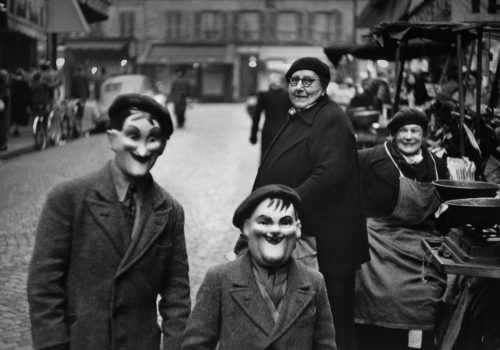Celebrated documentary photographer Elliott Erwitt was born in Paris in 1928 and spent his childhood in Milan before moving to the United States in 1939. The son of Jewish-Russian immigrants, he lived in New York City for two years before attending high school and college in Los Angeles. While in Los Angeles, he was first exposed to photography in a commercial photography studio and then went on to study filmmaking and photography at Los Angeles City College.
In 1949, he returned to Europe to further pursue artistic photography where he traveled around France and Italy. In 1951, Erwitt was drafted in the U.S. Army and again took the opportunity to photograph Europe, specifically France and Germany. He eventually returned to New York where he was to settle and met Robert Capa, Edward Steichen, and Roy Stryker who would become guiding mentors for Erwitt. Stryker was the director of the Farm Security Association’s photography department and he hired Erwitt to work on a photography project for Standard Oil. Erwitt would then start a freelance photography career working for such publications as LIFE, Look, and Collier’s. Robert Capa would later induct Erwitt into Magnum Photos and Erwitt would also serve as president of the organization for three terms starting in 1968.
Besides being a successful Magnum photographer who is still contributing to the organization, Erwitt is also an accomplished filmmaker and producer. He has made several independent documentaries and produced seventeen programs for HBO. He has personally authored over twenty photography books as well. His work is in the collections of the Museum of Modern Art in New York, the Smithsonian Institution in Washington DC, The Art Institute of Chicago, the Reina Sofia in Madrid, and countless other public and private collections. In 2011, Erwitt was honored with a major retrospective at the Institute of Contemporary Photography in New York and awarded the ICP Infinity Award for Lifetime Achievement.
Sara Tasini: Do you think your travels as a young child, from France to Italy to the United States, affected your vision of the world and contributed to how you made your pictures?
Elliott Erwitt: Of course it did, and constant travels throughout my private and professional life continue to do so.
If not from these early experiences, then from where do you think your sensitivity and keen observational skills to the world around you come?
Just general curiosity is the guiding principle.
When did you first realize that your pictures were gaining popularity? How did this affect your perspective?
I have been at it a very long time (photographing) and my perspective is unchanged since the start.
What is something fundamental that you learned during your time at Magnum Photos?
That you must never relinquish your copyright.
Looking back on your illustrious career, what were your favorite periods?
The 1960’s, which was the best time for editorial, documentary, and reportage photography.
You have mentioned that you find “amateur” photography more interesting than professional. What makes it more interesting for you?
Not being responsible to a client other than myself.
The “snap-shot” style that your work is often equated with – is this intentional?
I hope that everything I do in photography is intentional and not haphazard.
Do your pictures ever speak to your own identity? In other words, are you ever expressing bits of yourself, and not just capturing what you observe?
My personal pictures are from what I observe. My professional ones are based on what a client expects from me and pays me for.
It is something quite rare to find today, a person whose career is also his favorite hobby. How does it feel to be so lucky? Do you ever wish the two were mutually exclusive?
Both are very inclusive and often cross.
Do you have other hobbies?
Not yet. But I am working on finding one.
Was there ever a time when you doubted that a career in photography could sustain you financially?
My career has been good to me and my four wives and eight grandchildren (so far).
How do you choose which pictures you exhibit? Is it a matter of popular consensus, curatorial requests, or your own personal favorites?
With museums it has a lot to do with the space, type, and quality of the venue. Naturally I select the pictures that most represent my interests and style.
What changes in photography have you observed over the years?
The only changes have been in connection with the professional marketplace. There are no changes in my own personal work, at least none in the past 60 years.
What is it about photography that has kept you interested and working consistently for so many years?
Essentially that it is my hobby, and the need to adapt to the inevitable changes in life and work.
This interview is part of a series conducted by Holden Luntz Gallery, based in Palm Beach, Florida.
Interviewer: Sara Tasini
Holden Luntz Gallery
332 Worth Ave
Palm Beach, FL 33480
USA
















